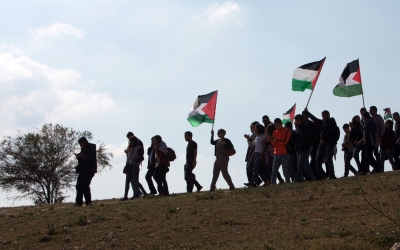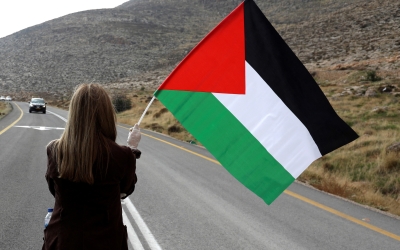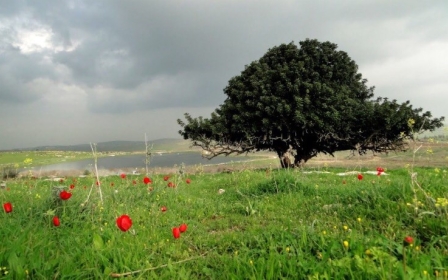How the Palestinian elite failed to prevent Israel's land theft

The main trigger to the uprising and resistance that engulfed Palestine last May was no different from every trigger since the early 1880s - namely the ongoing Jewish colonists’ theft of Palestinian land.
Zionism's attempts to steal land have always been the cornerstone of the movement. The Jewish National Fund (JNF), founded in 1901, and its subsidiary, the Palestine Land Development Company (1908), set out to drive Palestinian peasants off their land by acquiring land from the Ottoman authorities and big absentee landlords from Beirut, Damascus and Cairo.
Many of these deals were carried out surreptitiously and illegally, as they continue to be today. Indeed, another JNF subsidiary front, called Himanuta, has been entrusted in recent years with executing legally questionable land deals in the West Bank.
Neither the Palestine Liberation Organisation nor the Palestinian bourgeoisie made any serious efforts to save Palestinian property and land from theft
After Israel occupied the rest of Palestine in 1967, no effort was made either by the former Palestinian landed elite, or the emergent Palestinian bourgeoisie to block Zionist acquisitions of the land of the Palestinians.
The 1967 Israeli colonial takeover of the West Bank, including East Jerusalem and Gaza, reinvigorated the colonial theft of Palestinian lands, with East Jerusalem and its surrounding towns and villages becoming a special focus for the Israelis since the early 1970s.
Neither the Palestine Liberation Organisation (PLO) nor the Palestinian bourgeoisie has made any serious efforts since then to save Palestinian property and land from theft. In fact, in 1993, many Palestinian businessmen supported the Oslo Accords surrender, which offered them opportunities for large profits under Israeli occupation.
Palestinian efforts to stop the appropriation of lands hark back to the beginning of the Zionist project. Once Britain became the official sponsor of the European Jewish colonial-settler project in 1917, it occupied Palestine and began to enact laws and regulations to facilitate land transfers to the Jewish colonists. This was a transformational moment in the fortunes of the Zionist movement.
The German model
The founder of the Zionist movement, Theodor Herzl, understood this well when he insisted in his 1896 pamphlet, The State of the Jews, that “a gradual infiltration of Jews… is bound to end badly. It continues till the inevitable moment when the native population feels itself threatened, and forces the Government to stop a further influx of Jews. Immigration is consequently futile unless we have the sovereign right to continue such immigration".
The Zionists had a model in mind for how to colonise Palestine - namely the German model.
In 1871, newly unified Germany planned to colonise its eastern provinces of West Prussia and Posen - which had a majority Polish population - by Germanising them through German settler-colonisation and the suppression of Polish national identity.
The plan, organised by the Royal Prussian Colonisation Commission, was to move about 40,000 German families to the Polish-majority provinces.
By 1918, the commission had only been able to buy eight percent of the land, most of it in Posen. Through the 1908 German Expropriation Act, the Germans had also confiscated 70,000 hectares of Polish lands in areas whose “Germanness” was being threatened. They established hundreds of small German settler colonies. In addition to the 155,000 civilian colonists, there were over 378,000 German military personnel and officials who lived in the Polish regions.
But the colonisation scheme backfired by rousing up Polish nationalism, which it had intended to quash. Indeed, in 1886 Polish landowners had set up the Polish Land Bank (Bank Ziemski) to purchase land from struggling Polish landowners and move Polish peasants onto it. By 1918, the Polish proportion of the population had increased in the two provinces, and Polish ownership of land had also increased.
Despite the failure of the German colonisation of Posen, it became a model for early 20th-century Zionists in their efforts to colonise Palestine (a country roughly the size of Posen).
The Palestine Bureau of the Zionist Organisation (ZO) was headed by the German Jew and Posen-born Arthur Ruppin. Ruppin had witnessed “the permanent struggle between the Polish majority living on the land and the dominant, mainly urban, German population”.
Feeble attempts
Two weeks after his arrival in Palestine in 1907 to explore Jewish colonisation of the country - a trip funded by the ZO’s Jewish National Fund (JNF) - Ruppin wrote to the JNF that “I see the work of the JNF as being similar to that of the Colonization Commission working in Posen and Western Prussia. The JNF will buy land whenever it is offered by non-Jews and will offer it for resale either partly or wholly to Jews”.
The Palestinian context seemed to replicate the Polish one, except that unlike the Polish landed elite, the Palestinian landed elite failed utterly at resisting Zionist colonisation. Like the Poles, the Palestinian anti-colonial nationalists issued warnings to those who would sell lands to the Jewish colonists, and in the 1930s, religious injunctions by Muslim and Christian Palestinians banned land sales to the colonists.
Some feeble attempts by the Palestinian landed elite to buy land for the dispossessed peasants began through establishing Palestinian banks, especially the Arab Bank (1930) and Ahmad Hilmi Pasha Abd al-Baqi’s Arab Agricultural Bank (1933), while the Palestinian Supreme Muslim Council bought land and converted it to charitable endowments - Waqf - to be held in perpetuity.
There was also the Palestinian Arab National Fund (Sunduq al-Ummah), established in 1932-33 to purchase lands on behalf of the Palestinian Arab Executive (the body representing the Palestinian people, unrecognised by the British). It opened branches across Palestine.
A second effort was started by the Arab League Land Development Plan of 1945 (known as “Al-Mashru’ al-Insha’i” or the “Construction Project”), which aimed at preserving Arab land and alleviating the social and economic conditions of the peasants. The plan sought to pay off massive peasant debts, improve agricultural methods and carry out village construction. The intention was not to buy land, although that is what the scheme ended up doing.
These efforts, however, came too late, as within months the Jewish colonists had conquered much of Palestine
Ultimately, Musa al-Alami, a Palestinian politician from an elite landed family, started the project on his own with Iraqi funds, as no funds seemed forthcoming from the Arab League. His project began to compete with the Arab National Fund, set up by Baqi.
Neither was well-funded or that effective. By late 1945, the fund had acquired about 12,800 dunams while the Construction Project was on the verge of collapse.
The Palestinian Arab Higher Committee (AHC), which replaced the Arab Executive in 1935, was dissolved by the British in 1937 due to its support of the revolt. When it was re-established in 1946, plans were made the same year by the Mufti Amin al-Husayni and the AHC to establish the “Bayt al-Mal al-Arabi” as its treasury to collect taxes and save Palestinian lands.
Bayt al-Mal sought to amalgamate the National Fund and Alami’s Construction Project within it. The treasury was publicly proclaimed in April 1947. Hilmi Abd al-Baqi supported the amalgamation but Alami refused to join. Bayt al-Mal al-Arabi, meanwhile, set up six major branches.
Failure of the Palestinian bourgeoisie
These efforts, however, came too late, as within months the Jewish colonists had conquered much of Palestine, driven the bulk of the Palestinians from the area they occupied and confiscated all their lands, which became a trust for world Jewry in perpetuity.
Unlike the Polish landlords who were able to thwart Germany’s efforts to undermine the Polish demographic presence and their land ownership in their provinces, the Palestinian landlords failed at their task miserably, as has the Palestinian bourgeoisie since 1967.
Indeed, even today, the Palestinian “Welfare Association,” founded in 1983 by Palestinian businessmen in Geneva, still does not include any effort to safeguard the lands of the Palestinians, although it sponsors projects such as the Old City of Jerusalem Revitalisation Program (OCJRP). Ironically, one Palestinian business venture colluded with the Palestinian Authority to confiscate Palestinian village land to establish a bourgeois neighbourhood near Ramallah, known as Rawabi.
One bourgeois effort stands out concerning asserting Palestinian land rights in West Jerusalem - related to the recently established US embassy in West Jerusalem in 2018, which is being built on stolen Palestinian property.
In 1989, based on the US Congressional Helms Amendment, an agreement was signed between Israel and the US according to which a 7.7-acre plot of land in occupied West Jerusalem was leased to the US government for a rent of $1 per annum for 99 years. The property is located in what was known as Allenby Barracks, the site of the British army's Jerusalem garrison during the mandate.
As Palestinian historian Walid Khalidi has demonstrated, the property belongs to 19 Jerusalem families. Of these 19, 15 were Muslim Arab and four were Christian Arab. Eight of the 15 Muslim families were beneficiaries of the Khalili Waqf to which much of the land belonged. In 2000, Khalidi identified 90 US nationals as heirs of the original owners, as well as 43 heirs with Canadian or European nationalities.
Too little, too late
In June 1995, the late Palestinian businessman Hasib Sabbagh established the American Committee on Jerusalem (ACJ) to include the major Arab American organisations and other groups concerned about the future of Jerusalem. Attempts by the ACJ to challenge the US government on the lease came to nought. It ceased to exist in 2003.
Meanwhile, the Zionists proceed with their theft of Palestinian lands through bogus purchases and illegal confiscations
Rather than set up a fund to save the lands of the Palestinians, the ACJ was transformed into an unofficial lobbying organisation for the PA called the American Task Force on Palestine, which proceeded to nullify the Palestinian refugees’ right of return to their lands before disappearing from the Washington scene. After Donald Trump finally approved the late 1980s Congressional Act of moving the US embassy to West Jerusalem, building began on the Palestinians’ stolen property this year - including that of US citizens.
Meanwhile, the Zionists proceed with their theft of Palestinian lands through bogus purchases and illegal confiscations. Recent rumours have it that there are currently small ongoing efforts on the part of some wealthy Palestinians to embark on a project of purchasing Palestinian lands in East Jerusalem and transforming them into Islamic endowments or Waqf, and that indeed such purchases are said to have already been made.
If true, these efforts may be too little, too late. The only sure thing that continues to stand in the face of the ongoing Jewish colonists’ land thefts is the resistance of the Palestinian people themselves, their negligent and collaborating bourgeoisie notwithstanding.
The views expressed in this article belong to the author and do not necessarily reflect the editorial policy of Middle East Eye.
This article is available in French on Middle East Eye French edition.
Middle East Eye propose une couverture et une analyse indépendantes et incomparables du Moyen-Orient, de l’Afrique du Nord et d’autres régions du monde. Pour en savoir plus sur la reprise de ce contenu et les frais qui s’appliquent, veuillez remplir ce formulaire [en anglais]. Pour en savoir plus sur MEE, cliquez ici [en anglais].








